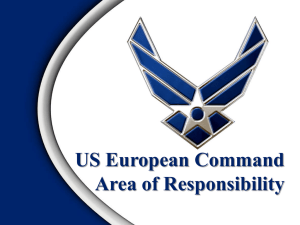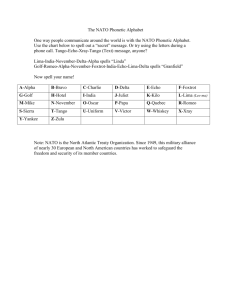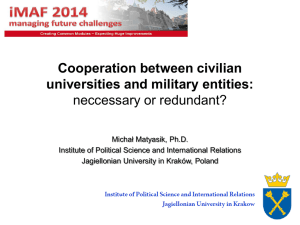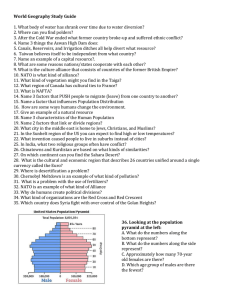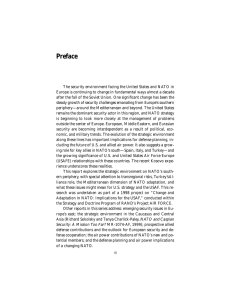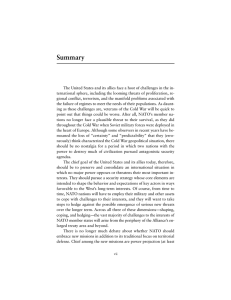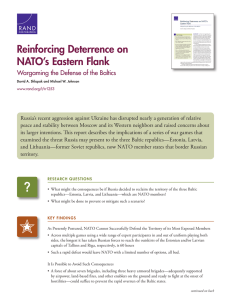Objectives and Strategy
advertisement
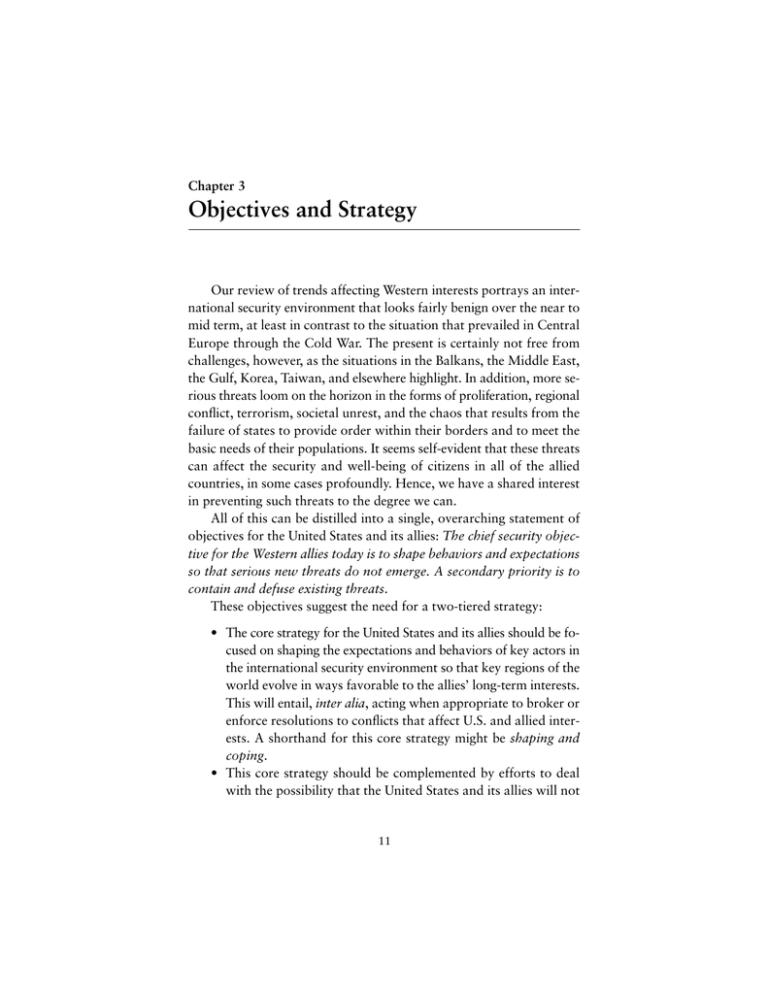
Chapter 3 Objectives and Strategy Our review of trends affecting Western interests portrays an international security environment that looks fairly benign over the near to mid term, at least in contrast to the situation that prevailed in Central Europe through the Cold War. The present is certainly not free from challenges, however, as the situations in the Balkans, the Middle East, the Gulf, Korea, Taiwan, and elsewhere highlight. In addition, more serious threats loom on the horizon in the forms of proliferation, regional conflict, terrorism, societal unrest, and the chaos that results from the failure of states to provide order within their borders and to meet the basic needs of their populations. It seems self-evident that these threats can affect the security and well-being of citizens in all of the allied countries, in some cases profoundly. Hence, we have a shared interest in preventing such threats to the degree we can. All of this can be distilled into a single, overarching statement of objectives for the United States and its allies: The chief security objective for the Western allies today is to shape behaviors and expectations so that serious new threats do not emerge. A secondary priority is to contain and defuse existing threats. These objectives suggest the need for a two-tiered strategy: • The core strategy for the United States and its allies should be focused on shaping the expectations and behaviors of key actors in the international security environment so that key regions of the world evolve in ways favorable to the allies’ long-term interests. This will entail, inter alia, acting when appropriate to broker or enforce resolutions to conflicts that affect U.S. and allied interests. A shorthand for this core strategy might be shaping and coping. • This core strategy should be complemented by efforts to deal with the possibility that the United States and its allies will not 11 12 NATO’S FUTURE: IMPLICATIONS FOR U.S. MILITARY CAPABILITIES AND POSTURE be universally successful in preventing the emergence of serious new threats. Hence, a hedging strategy is needed to ensure that the requisite capabilities will be in place to meet more stressing threats that might arise. What do these strategies mean in specific terms? Shaping The United States and its allies bring to bear a host of instruments—many of them nonmilitary—in their efforts to shape the behavior and expectations of others. As noted previously, formally extending security guarantees to selected states is perhaps the most powerful tool available to policymakers interested in stabilizing regions where important interests are at stake. The extension of security guarantees reduces pressures on new members to seek costly and potentially destabilizing military capabilities that might be seen as needed should a newly independent state have to provide for its own defense. Prospective membership in NATO has also had notable side effects, including increased investor confidence and the accelerated economic growth that accompanies investment capital. And by outlining criteria desirable for new members, including the renunciation of force to settle disputes, adherence to democratic principles, and respect for minority and human rights, NATO has helped to promote adherence to responsible and stabilizing policies. Indeed, the possibility of accession into NATO has provided strong support to those who seek to promote reformist agendas in states formerly ruled by communist parties. The military forces and staffs of NATO member states have promoted the spread of Western-oriented systems and policies by providing advisory assistance to their counterpart organizations in countries formerly dominated by Moscow. Since the early 1990s, U.S. and allied military establishments have been sending teams of specialists—commissioned and noncommissioned officers, as well as civilians—to foreign defense ministries and parliaments where they instruct their hosts on subjects ranging from NATO military doctrine and training to defense planning and programming. These advisory teams also provide OBJECTIVES AND STRATEGY 13 examples of Western-style civil-military relations, emphasizing the importance of the rule of law and the roles of elected legislatures and executives in controlling military expenditures and activities. Participation by officers of other countries in NATO nations’ professional military education courses reinforces these messages. Multinational field training, exercises, and operations have always been important vehicles within NATO for improving military proficiency and increasing the ability of forces from different nations to operate jointly. Since the early 1990s, NATO has conducted an increasingly vigorous program of combined training exercises involving non-NATO nations, as part of the Partnership for Peace (PFP) program. These events reinforce messages given by Western military advisors. They also are invaluable for increasing mutual trust and confidence among people from nations that were for decades locked in an adversarial relationship. And when U.S. or allied forces deploy to another country to conduct training, this sends a message to friends and potential foes alike that Western forces have the capacity to contribute to that country’s defense. Shaping activities are also directed toward reducing the threat posed by weapons of greatest concern. In particular, containing the threat posed by longer-range ballistic and cruise missiles and by weapons of mass destruction (WMD)—nuclear, chemical, and biological weapons—will become a growing preoccupation of the United States and its allies in the years to come. In the hands of states bent on challenging Western interests, these weapons can pose serious challenges to forces operating within their range. In the hands of terrorists, they raise the prospect that small groups that are difficult to identify, deter, or strike can inflict horrific damage on defenseless populations. NATO has reduced proliferation pressures in Europe in the first instance by helping to stabilize the region. During the Cold War, NATO’s security umbrella (centered on American security guarantees and supported by nuclear and conventional arsenals) allowed most of the technologically advanced nations of Western Europe safely to forgo the nuclear option. The same is true for NATO’s new members, some of whom might have felt compelled to move toward the development of independent deterrent forces in the absence of credible security guar- 14 NATO’S FUTURE: IMPLICATIONS FOR U.S. MILITARY CAPABILITIES AND POSTURE antees. Similarly, NATO’s less-formal assurances to Ukraine helped that nation to rid itself of nuclear weapons and delivery vehicles left there after the demise of the Soviet Union. In spite of these successes, the prospect is for growing missile and WMD threats from states on Europe’s periphery. NATO nations will require a multipronged approach to the problem. Specifically, the United States and its allies will seek to: • Impede the flow of technologies related to the development of WMD, ballistic missiles, and cruise missiles to nations and groups espousing hostile security objectives • Deter the use of WMD by retaining the capacity to retaliate with devastating effects • Defeat attacks on Western and allied forces and territory through a combination of active defenses, passive protection, and capabilities to locate and destroy WMD before they are used • Develop operational concepts for power projection that reduce the exposure of expeditionary forces to WMD attacks. We return to the implications of the WMD problem later, but suffice it to say for now that neither NATO nor its members have yet come fully to grips with the problem in their defense planning and resource allocation priorities. Coping The coping dimension of the core strategy involves efforts to resolve or neutralize existing and emerging threats to Western interests. In the post–Cold War period, NATO members have faced immediate challenges from overt aggression by Iraq in 1990, as well as from terrorist attacks, simmering disputes between Greece and Turkey and within Turkey itself, and, most wrenchingly perhaps, persistent and widespread violence in the former Yugoslavia. Conflicts further afield, including the genocide in Rwanda and the rampant violence in Algeria, have also raised concerns among populations and governments in NATO member countries. OBJECTIVES AND STRATEGY 15 Often military power must be brought to bear, either implicitly or explicitly, to compel a satisfactory resolution to such challenges. Depending on the circumstances, virtually the full range of military capabilities may called upon. Capabilities often in demand include: • Multinational planning, coordination, and control of military operations • Providing humanitarian relief to victims of violence or natural disasters • Monitoring military activities in regions where conflict might occur or is occurring • Imposing and monitoring embargoes on the shipment of unauthorized goods by land, sea, or air • Training and equipping local forces for their own defense • Rapidly deploying air, naval, land, and amphibious forces to regions in conflict, and sustaining these forces once deployed • Coercing or punishing enemy leaders through precise attacks on military, political, and economic assets • Preventing or defeating military actions by one or both parties to a dispute. The latter may call for capabilities to accomplish a wide range of operational objectives, including protecting civilian populations from attacks by armed factions; gaining air and naval superiority; delaying, damaging, and destroying light and mechanized ground forces, supply columns, and their support infrastructure; providing support to friendly ground forces in the form of supplies, transportation, information, or fires; and defeating enemy ground forces in battle. This list of military capabilities relevant to NATO’s coping tasks will be familiar to students of modern military operations of almost any time and place. It bears noting, however, that the context and conditions under which NATO’s forces may be operating these days are likely to be quite different from the conditions for which those forces prepared a decade ago. These changes are summarized in the figure on the next page. During the Cold War, NATO’s planning and training were dominated by concerns about deterring and defeating large-scale aggression. In the event a major war in Europe occurred, it was as- 16 NATO’S FUTURE: IMPLICATIONS FOR U.S. MILITARY CAPABILITIES AND POSTURE Cold War Scale Large Post–Cold War Small Cost tolerance High Low Likelihood and frequency Low High Duration Short Long The Changing Context of Military Operations by NATO sumed that millions of combatants would be engaged and that truly vital national interests would be at stake, including the very survival of NATO’s member nations and their populations. Under these circumstances, the United States and its allies were willing to risk high costs in the event of war, including the loss of many thousands of combatants and the incalculable losses that would result from a large-scale nuclear exchange. The only solace one could take from this situation was that the potential costs and risks for both sides were so astronomical that the likelihood of war in Europe was deemed to be quite low. Today, the interests that NATO’s members have at stake in most prospective conflicts—such as violence in the Balkans—are, relative to “the big one,” modest and ambiguous. The territory, lives, and prosperity of most NATO nations are not today directly at risk from any plausible conflict (Turkey and perhaps Greece being the sole exceptions). Yet the interests involved in areas around NATO’s periphery are not negligible: Western nations have important economic interests in the Persian Gulf and Mediterranean regions. Even where no readily definable major national interests exist, many people in Europe and America feel some responsibility for the well-being of others, at least to the level of enforcing basic norms prohibiting officially sponsored vi- OBJECTIVES AND STRATEGY 17 olence against innocent civilians. Such concerns as these are prompting the leading nations of the international community to accept, however haltingly, the proposition that, in order to preserve international stability and the well-being of all, they must do what they can to prevent the most egregious violations of human rights in “local” or internal conflicts. By and large, citizens of NATO’s member states feel these responsibilities most keenly with regard to societies within Europe itself. This is understandable, given that violence in neighboring states can readily have spillover effects at home and that feelings of kinship are naturally stronger among groups with a shared historical and cultural background. The scale of conflicts for which we must prepare today ranges from quite small (a battalion or so, widely scattered, was deemed sufficient to deter deliberate aggression against Macedonia for several years prior to NATO’s intervention in Kosovo) to moderate in the case of another war in the Gulf. Appropriately, given the level of interests at stake, tolerance for costs—most especially human costs, in terms of casualties—is low. At the same time, these conflicts arise with depressing frequency and their underlying causes may persist for years, demanding the commitment of outside forces for extended periods. This very different context for post–Cold War contingencies has profound implications for NATO strategists and force planners. It means, among other things, that for military instruments to be relevant to the problems with which the Alliance is now coping, those instruments must be capable of being employed with high confidence that they can achieve their objectives without risking disproportionate loss of life. Not only will high casualties not be tolerated among friendly combatants, it has become increasingly clear that our forces must not, through their operations, make the situation appreciably worse for civilians in the region. That is, “collateral damage” must be kept to a minimum. “Technology,” observes one seasoned European strategist, “is not a luxury . . . the greater [our] concern about casualties, the greater the reason to exploit our technological advantages.”1 This is a 1 Air Vice Marshal Professor Tony Mason, “The Future of Air Power: Concepts of Operation,” unpublished paper delivered November 28, 1997 in The Hague, Netherlands. 18 NATO’S FUTURE: IMPLICATIONS FOR U.S. MILITARY CAPABILITIES AND POSTURE demanding set of criteria that cannot always be met, particularly when the forces we are trying to defeat adopt tactics that make it difficult to locate combatants and to separate them from the populace. But Western defense planners can anticipate that their nations’ decisionmakers will evince an enduring interest in military capabilities that can be employed with minimal risk of losses and collateral damage. Hedging Hedging involves taking prudent and affordable steps to prepare for unlikely but threatening future contingencies. If preparing to meet the threats of WMD and small- to moderate-scale military operations is an integral part of NATO’s core strategy, the principal unexpected threat against which NATO must plan would seem to be the potential reemergence of a large-scale conventional and nuclear military threat on or near NATO’s borders. As noted previously, the odds of such a threat emerging from Russia in the near term or even the mid term seem long indeed. This suggests that, whatever measures are deemed prudent for hedging against this threat, no urgent steps are called for. Nevertheless, fielding the capabilities needed to cope adequately with an adversary that deployed even one-third of the forces that the Soviet Union could have brought to bear against NATO in the 1980s would be a costly and time-consuming task. For this reason, prudence demands that steady efforts be made over the coming years to lay the foundations for such capabilities. Much of the necessary work will be undertaken as a matter of course: Plans are afoot to improve the readiness, training, equipment, and interoperability of NATO’s forces so that they may be able to carry out the missions assigned to them under the core strategy. For the most part, appropriate additional preparations center on developing infrastructure suitable for supporting large-scale military operations, particularly to the east and south of NATO’s enlarged treaty area. This infrastructure encompasses both the military and civil spheres. For example, military command and control facilities and communications centers in both old and new member states should be upgraded. Selected air bases in new member states also require upgrading. On the OBJECTIVES AND STRATEGY 19 civil side, transportation networks (roads, bridges, rail lines, and air traffic control), petroleum distribution networks, communications, and power grids all are relevant to military operations and may be in need of modernization. Again, most of these enhancements will be undertaken in any case as part of broader efforts to modernize the economies of new member states and to provide for the effective control of national borders and airspace. One special element of the hedging strategy is the infrastructure associated with U.S. nuclear weapons in Europe. All three dimensions of the strategy outlined here point to the value of retaining in Europe the capability to retaliate against those who might employ weapons of mass destruction against U.S. or allied assets in or around Europe. Such a capability is a useful hedge against the possible reemergence of a major military threat on NATO’s borders. It also helps to shape the environment positively by reducing the incentives others might have to acquire WMD or to threaten to unleash them against Europe. And, should such weapons be used, having the means of retaliation deployed in Europe would help to ensure a consultative and decisionmaking process among the allies characterized by shared risks and burdens. For these reasons, the Alliance will want to preserve the basic elements of the currently deployed capability.
